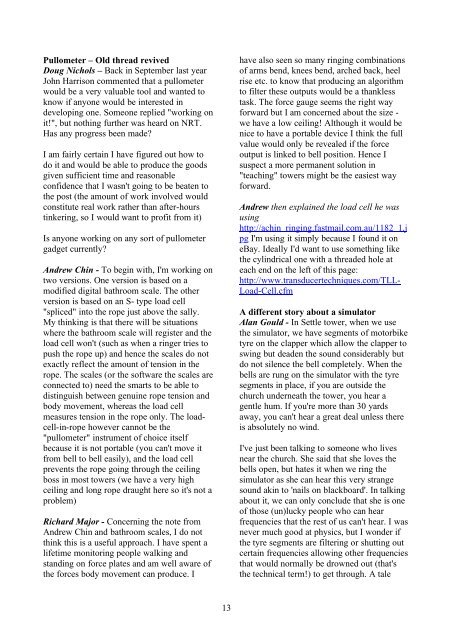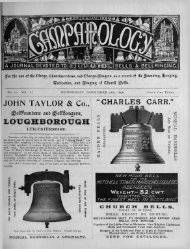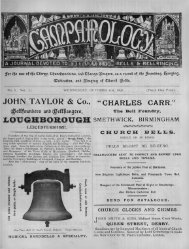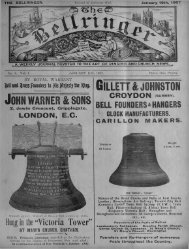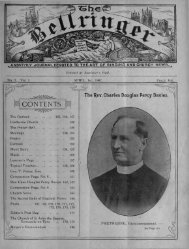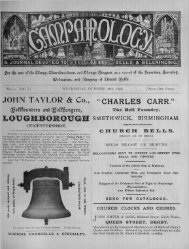The Central Council of Church Bell Ringers Education Committee
The Central Council of Church Bell Ringers Education Committee
The Central Council of Church Bell Ringers Education Committee
You also want an ePaper? Increase the reach of your titles
YUMPU automatically turns print PDFs into web optimized ePapers that Google loves.
Pullometer – Old thread revived<br />
Doug Nichols – Back in September last year<br />
John Harrison commented that a pullometer<br />
would be a very valuable tool and wanted to<br />
know if anyone would be interested in<br />
developing one. Someone replied "working on<br />
it!", but nothing further was heard on NRT.<br />
Has any progress been made?<br />
I am fairly certain I have figured out how to<br />
do it and would be able to produce the goods<br />
given sufficient time and reasonable<br />
confidence that I wasn't going to be beaten to<br />
the post (the amount <strong>of</strong> work involved would<br />
constitute real work rather than after-hours<br />
tinkering, so I would want to pr<strong>of</strong>it from it)<br />
Is anyone working on any sort <strong>of</strong> pullometer<br />
gadget currently?<br />
Andrew Chin - To begin with, I'm working on<br />
two versions. One version is based on a<br />
modified digital bathroom scale. <strong>The</strong> other<br />
version is based on an S- type load cell<br />
"spliced" into the rope just above the sally.<br />
My thinking is that there will be situations<br />
where the bathroom scale will register and the<br />
load cell won't (such as when a ringer tries to<br />
push the rope up) and hence the scales do not<br />
exactly reflect the amount <strong>of</strong> tension in the<br />
rope. <strong>The</strong> scales (or the s<strong>of</strong>tware the scales are<br />
connected to) need the smarts to be able to<br />
distinguish between genuine rope tension and<br />
body movement, whereas the load cell<br />
measures tension in the rope only. <strong>The</strong> loadcell-in-rope<br />
however cannot be the<br />
"pullometer" instrument <strong>of</strong> choice itself<br />
because it is not portable (you can't move it<br />
from bell to bell easily), and the load cell<br />
prevents the rope going through the ceiling<br />
boss in most towers (we have a very high<br />
ceiling and long rope draught here so it's not a<br />
problem)<br />
Richard Major - Concerning the note from<br />
Andrew Chin and bathroom scales, I do not<br />
think this is a useful approach. I have spent a<br />
lifetime monitoring people walking and<br />
standing on force plates and am well aware <strong>of</strong><br />
the forces body movement can produce. I<br />
13<br />
have also seen so many ringing combinations<br />
<strong>of</strong> arms bend, knees bend, arched back, heel<br />
rise etc. to know that producing an algorithm<br />
to filter these outputs would be a thankless<br />
task. <strong>The</strong> force gauge seems the right way<br />
forward but I am concerned about the size -<br />
we have a low ceiling! Although it would be<br />
nice to have a portable device I think the full<br />
value would only be revealed if the force<br />
output is linked to bell position. Hence I<br />
suspect a more permanent solution in<br />
"teaching" towers might be the easiest way<br />
forward.<br />
Andrew then explained the load cell he was<br />
using<br />
http://achin_ringing.fastmail.com.au/1182_1.j<br />
pg I'm using it simply because I found it on<br />
eBay. Ideally I'd want to use something like<br />
the cylindrical one with a threaded hole at<br />
each end on the left <strong>of</strong> this page:<br />
http://www.transducertechniques.com/TLL-<br />
Load-Cell.cfm<br />
A different story about a simulator<br />
Alan Gould - In Settle tower, when we use<br />
the simulator, we have segments <strong>of</strong> motorbike<br />
tyre on the clapper which allow the clapper to<br />
swing but deaden the sound considerably but<br />
do not silence the bell completely. When the<br />
bells are rung on the simulator with the tyre<br />
segments in place, if you are outside the<br />
church underneath the tower, you hear a<br />
gentle hum. If you're more than 30 yards<br />
away, you can't hear a great deal unless there<br />
is absolutely no wind.<br />
I've just been talking to someone who lives<br />
near the church. She said that she loves the<br />
bells open, but hates it when we ring the<br />
simulator as she can hear this very strange<br />
sound akin to 'nails on blackboard'. In talking<br />
about it, we can only conclude that she is one<br />
<strong>of</strong> those (un)lucky people who can hear<br />
frequencies that the rest <strong>of</strong> us can't hear. I was<br />
never much good at physics, but I wonder if<br />
the tyre segments are filtering or shutting out<br />
certain frequencies allowing other frequencies<br />
that would normally be drowned out (that's<br />
the technical term!) to get through. A tale


